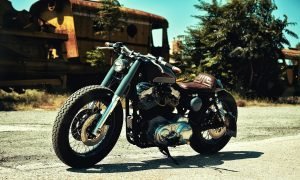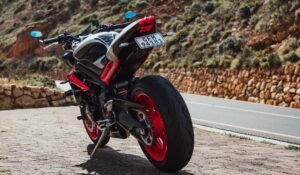A Complete Guide To Beginner Motorcycle Gear And Equipment
Updated on | By Mohit Chauhan
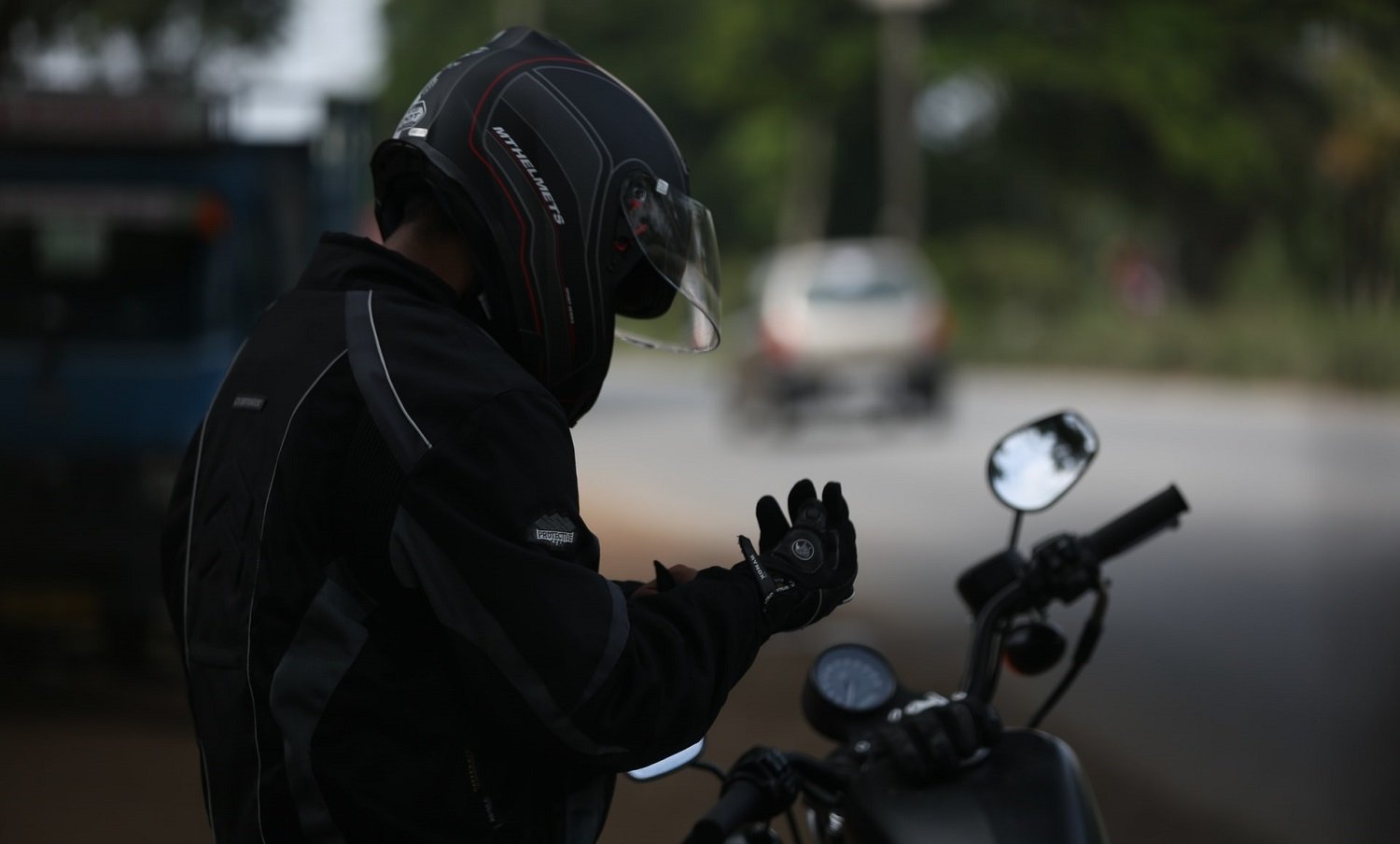
The human body just hasn’t evolved to go faster. This is why even falling from a horse (Guinness World Record: 70.76 km/h) can result in death. The last we checked, the fastest rider in the world was Johann Zarco. During his the fastest FP4, 2021 Qatar GP lap, his top speed was clocked at 362.4 km/h. If he had fallen at this speed without any gears and safety equipment, it is highly likely that he would have suffered serious injury as our skin, bones, and organs are not designed to withstand huge impact.
Even if the impact is not huge, there can be major abrasions. As a matter of fact, you can lose half an inch of flesh with every kilometer per hour you ride over 30km/h during a crash. And with a speed of 60km/h, which is pretty normal; you can lose more than an inch of your skin and muscle. Where on your body can you afford to lose so much? And what if you crashed at 100km/h, and lose more than 2 inches of your flesh. These crashes can turn out to be fatal solely due to abrasions and nobody can afford that.
Fortunately, our technology has achieved through science what evolution has failed to provide: safety gears that protect you from accidents while simultaneously making the ride easier and more comfortable.
Agreed, that once you have an approved A2 motorcycle license in your hand, it is natural that you may forget about the safety and focus more on your beginner bike. And with all the excitement and adrenaline rushing through the blood, it is quite common among beginners to ignore the riding gears. Nevertheless, let’s not forget that it’s the rider that is more important when compared with a motorcycle, period!
From the very first hour of your driving, you will need to equip yourself with at least a helmet, a jacket, and a pair of boots and gloves. All these motorcycle gears are important in their own way – without any of them, in the event of a fall, collision or accident, the likelihood of serious injury increases significantly. And even if you think that you will not drive too aggressively and boldly at first, very often accidents happen without the riders fault. In today’s blog, we will discuss about choosing the right motorcycle gear for beginners that are ideal as per your style, comfort, and are the best when it comes to safety. Considering the class of riders (A1 / A2), we will keep our budget below $200. So without any further ado, let us begin.
Types of Motorcycle Gear
There are primarily four main types of protective gears and equipment for motorcycle enthusiasts: Sports, Urban, Dirt / Motocross and Touring. We will not cover the sub categories of motorcycle types, since the main classification covers 99% of possible scenarios.
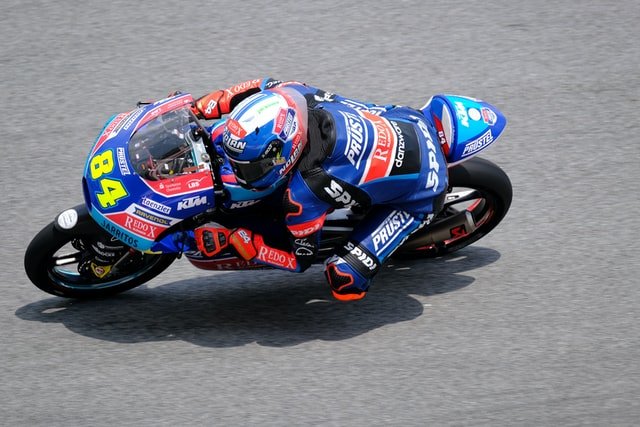
Sports Gear
Track is a place where riders take risks and set records. Each type of motorcycle has its own requirements, but sports bike demand utmost safety of the riders due to their aggressive engines. Thus, these gears have a monstrous size with shoulder, arm, knee, hips and chest guards and an additional hump shaped protector for the back, which is also helpful in improving the aerodynamics. Jacket and pants generally come together as a single suit.
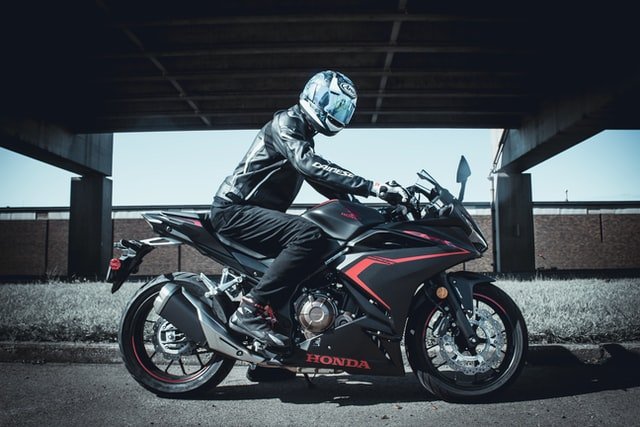
Urban Gears
These come usually as separate outfits with good ventilation, multiple pockets and are comfortable both while riding as well as after. They are generally made from textile cloth and come pre-equipped with shoulder, elbow and back protector. The urban gears also consist of short gloves with protectors around the fingers and wrist, special motorcycle jeans made of abrasion-resistant fabric and knee protectors. Boots can be either sports type or regular heavy ones.
When it comes to Helmets, the most popular is the full faced CE or DOT certified. Chopper owners often buy modular or open helmets, while the others prefer dual sport helmets.

Dirt / Motocross Gears
These gears are rigid and strong, but at the same time they allow you to move easily. Special Moto cross boots provide good ankle bracing against any twists and have large number of protective straps so that they are firmly affixed on the foot. Knee protectors are mostly articulated to prevent any kind of dislocation. When it comes to jackets, the upper body is protected by a vest that has guards on the chest, back and shoulders. The cross helmet has a special reinforced chin bar without any visor; the riders wear cross goggles instead that protect them from mud. The riding pant is made of special abrasion resistance material that is worn on top of the knee guard.
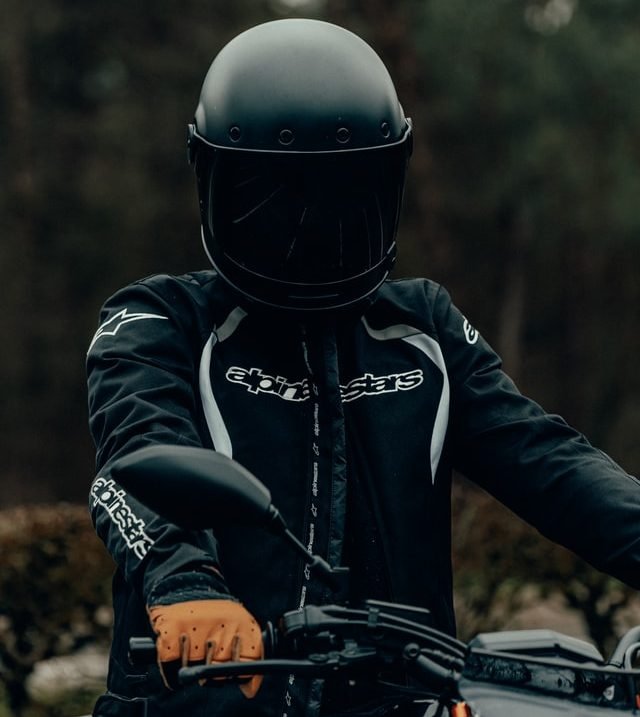
Touring Gears
Touring gears require good moisture protection and thermal regulation. The jackets and pants are generally made from different layers of textile fabrics with protective guards and pockets. Each of the fabric has a unique function thus making the ride extremely comfortable as well as safe. They come equipped with numerous settings and adjustments to suit the body type and riding posture. Helmets are most commonly the dual sports type with a heavy duty visor that protects against wind, water, dirt and sun.
Essential Motorcycle Gears For Beginners
So your dream of becoming a motorcyclist has finally come true, and you are a happy owner of your first motorcycle. Now is the time for choosing the right motorcycle gear as they will protect you from the possible consequences of an accident. As they say: “You can never have too much of a good thing.” It is important to understand that the choice of your gears will directly correlate with the safety and comfort of your motorcycle ride. Thus the essential things to keep in mind while choosing motorcycle gears are:
- They should protect all the vital organs of the body.
- They should be chosen depending on your motorcycle and riding type.
- Badly fitted gears should be avoided.
- Comfort and safety should be considered above style, period.
We will now discuss essential list of gears and equipment for beginner motorcyclists in detail.
Helmets
Let’s start by choosing a helmet. Almost all the countries require a motorcyclist to wear a helmet while riding. The helmet makes your motorcycle ride not only safe, but also comfortable by protecting your eyes from the wind, dust, and midges. There are different types of helmets in shape, size, material, and appearances, so it is important to consider safety above all the factors while choosing one.
General requirements for motorcycle helmets:
- The helmet can be easily and quickly removed.
- It should not block any view.
- It should be comfortable while riding for long stretches.
Further reading: Motorcycle helmet size guide
Types of Motorcycle Helmets
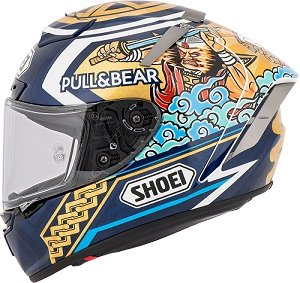
Integral Helmet
Integral is a classic, closed, full faced helmet. This type is used in the city, on the track and while touring. They offer the highest level of safety by fully protecting the entire head. Full faced helmets have an excellent protection level; they are aerodynamic and are completely insulated to limit the external noise from entering. They have the most versatile look and are the most uncomplicated among all motorcycle helmet types.
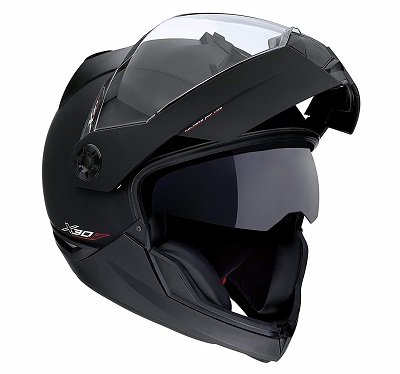
Modular Helmet
Modular helmets are closed helmets similar to integral but with a sliding lower jaw. Although they usually has the same test certificates as integrals, but they are considered less secure because they are not completely closed. Yet while riding, they can be quite comforting when you need to stop for a drink or smoke without removing your helmet. They are also more equipped with additional options (space for a headset, glasses, etc.) than an integral.
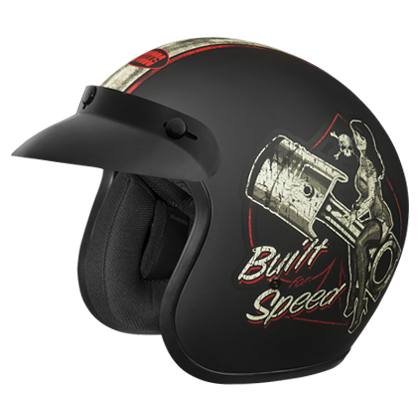
Open Helmet (3/4)
Three-quarters, aka open face, aka open helmets are motorcycle helmets without chin protectors. The visor is optional in these types and they provide a much better view of the surroundings. However, about a quarter of all head injuries occur on the jaw during an accident, thus making open helmets a mere trade-off between convenience and safety.
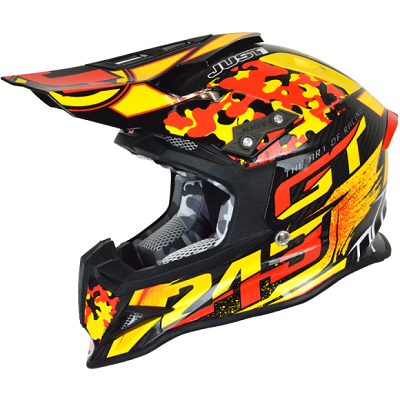
Cross Helmet
Cross helmets are generally used by motocross riders. The chin arch is reinforced and extended forward to facilitate breathing. To protect the face from stones flying from under the wheels, a long peak is also installed. There is no visor and the riders need to wear special motocross goggles to protect their eyes. Due to its complex shape, at high speeds, the helmet transfers more aerodynamic pressure to the rider’s head compared to the integral.
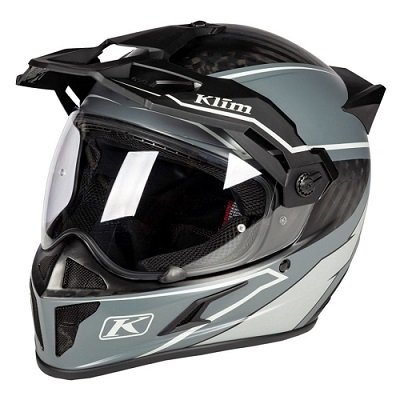
Dual Sport
Dual sport, also known as dual-use helmets are a mix of integral and cross helmets. They come with or without peaks and with or without visor depending upon your riding style. Recently, they have gained more popularity among the adventure tourers as they serve both general as well as enduro demands.
Further reading: Beginner motorcycle helmets
Motorcycle Jackets
The next important piece of equipment is the motorcycle jacket. Jackets usually come with built-in protection for shoulders, elbows, and back. The back, in general, is either weakly protected or not protected at all. Therefore, it is very often necessary to additionally purchase either a rigid protection and replace the standard back protection with it or a separate back protection with straps that can be worn under a motorcycle jacket. They also come in several types; motocross, touring, sports and urban. Let’s discuss them one by one in detail.
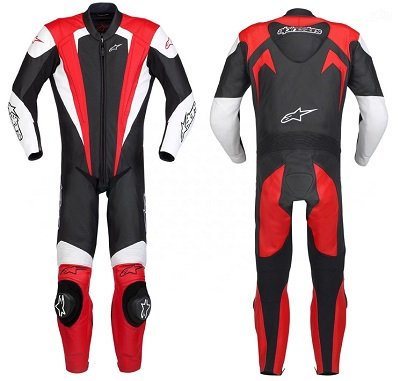
Sports / Jumpsuits
Commonly made of leather, they have a developed protection system designed to save the rider while falling at a significant speed. They are used practically for a sliding accident than an impact clash. These are sewn for the convenience of riding on a sports bike, and not intended for walking or even standing straight.
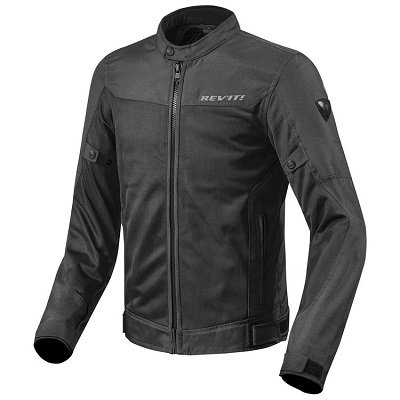
Urban / Casual
The degree of protection is lower than that of sports gear and is often sold with entry-level impact guards. However, these impact guards are replaceable. Depending on the price, they may include various features such as membrane lining, ventilation holes, etc. Once the protective guards are removed, these jackets can be used in everyday life. The complete set of protective guards and their number also depend on the price – there may be shoulder protection, long or short back protection, elbow and forearm protection, and chest protection. In any case, the jacket may have pockets for all or some of the elements and may or may not have impact guards in these pockets – pay attention to this while purchasing.

Touring Jacket
Touring jacket are usually similar to urban jackets, but have a large number of features. They include layers that protect from cold and rain, a breather vent to reduce sweating due to heat, and reflective stripes to reduce accidents. They are long as well to protect the lower back from strong winds, and an easy access to multiple pockets with locks to securely store your phones, documents and other important stuffs. However, due to these added features, they are quite pricey.
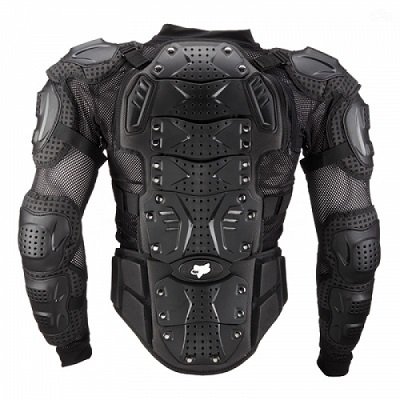
Turtle Jackets
Designed for motocross, it is also purchased by those who consider the protection of urban jackets to be insufficient. It is put on under a jacket, and in hot weather – just over a T-shirt or even without it. It has better protection against impact, but if you slip on the asphalt, the mesh fabric will immediately fray. Therefore, one of the most ideal options for the city ride is a turtle along with a motorcycle jacket on top (with the layers removed of course). It has protective guards for the back, shoulders, elbows and forearms. In some cases, the back can be detached and worn separately, and can also be sold as an independent piece of equipment.
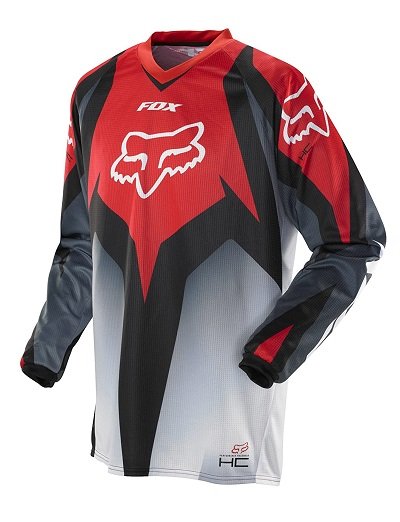
Jersey
Similar to T-shirts that are easily frayed, Jerseys do not provide any protection. Its primary task is to take on the dirt and sliding in motocross, and to protect the turtle jacket worn inside. It is usually inexpensive.
Also read: Best Motorcycle Jackets For Summer
Motorcycle Pants
Motorcycle pants come equipped with built-in protection for hips, buttocks and knees. They are designed to protect the rider’s legs not only from accidental damage, but also from heat and water. Motorcycle pants are generally divided into four main types;
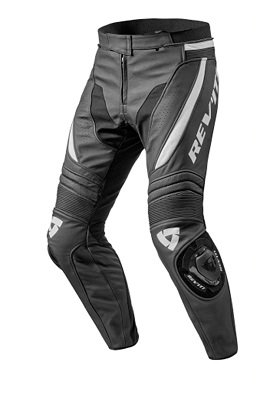
Sports Pant
It is primarily suitable for riders with aggressive or sporty riding style. They usually come as a part of a complete jumpsuit or can be purchased separately. They are built for sliding fall rather than impact, thus making them restricted to a specific riding style only. Additionally, sports pant have a very tight fit which may restrict the body movement to some extent.
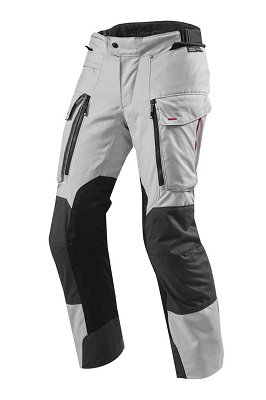
Textile / Touring Pants
Textile motorcycle pants are ideal for both types of touring that includes long distance motorcycle tours as well as intercity commuting on a daily basis. These are made of modern fabric that is durable and abrasion resistant. Also with the use of Gore-Tex type membranes, which do not allow water, cold air and dirt to pass through, but at the same time allow the foot to breathe; these riding pants have become quite common among riders.
Further reading: Waterproof Motorcycle Pants For Beginners

Urban Pants / Jeans
Motorcycle jeans are an alternative to textile pants, with less protection but a more stylish look. These are more budget-friendly option for textile pants, but in our opinion they are more elegant than safe. However, it is a good and practical option for urban riders. The fabric is reinforced with special threads to protect it from abrasion, the protective guards are removable and do not protrude much outward, providing a lower level of protection compared to other types, but good enough for city rides.
Read more: Motorcycle Jeans For Women
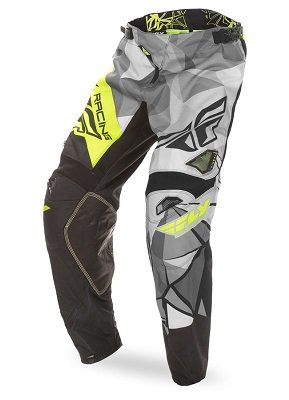
Cross Pants
Enduro pants or Cross pants are specialized clothing for motocross. They are a set of powerful protective riding pants that are focused on impacts. In addition to knee pads, “armored belts” are used, which provide basic protection for the tailbone and thigh. Apparently, it is assumed that hitting the booty on the mud is not as painful as on the asphalt. But let’s be honest – if these are stones, the impact will not seem like little.
Motorcycle Shoes
The next piece of gear is motorcycle boots. This is not just a stylish accessory but the most idealistic way to protect the rider’s legs. Of course, they are not as comfortable as sneakers, but trust us, it is completely worth to endure some discomfort rather than not being able to ride at all. Motorcycle boots can be classified basis what you plan to do with your two-wheeled friend.
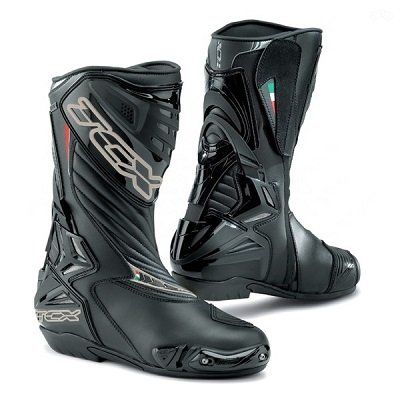
Sports Boot
Sports boot are high and quite rigid. Walking in them is sheer torment. As with any sporting gear, there principle is solely focused on protecting the riders during slide. Not to forget the shoe slider; a plastic guard with bolts on the side of the toe, is a mandatory gear while riding on a track. When a motorcyclist puts in a corner during race, he tilts the bike very strongly, even to the point of touching the track with his knee and foot. In order not to damage the leg and as a kind of limiter, special plates are wound on the boots. These types of boosts are strictly designed to ride on a track.
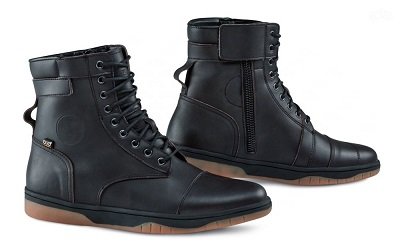
Casual Boots
Urban boots or Casual boots are made around the manufacturer’s imagination. They are made for daily commute and thus have gear shift pads around them that assist while shifting the gears up and down. In addition, they provide a good ankle support from any significant impact or slide. They look like regular sneakers, but are equipped with additional protection.
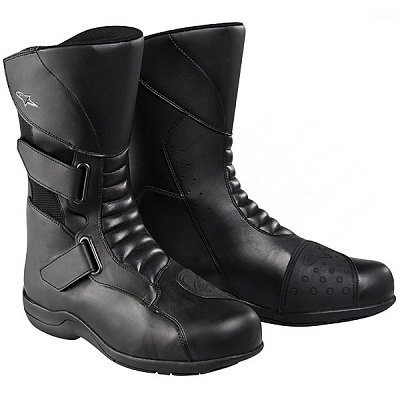
Touring Boots
Motorcycle boots for adventure touring, like the rest of the gears in this category, are more comfortable, tall, and equipped with the necessary technologies that will help your legs not smell like chemical weapons after a day in the saddle. A Gore-Tex membrane or the like (breathable, waterproof) is almost a prerequisite for these boots. Of course, it is more comfortable to walk in them than in sports or sneakers, but the protection is somewhat less. The priority here is convenience.
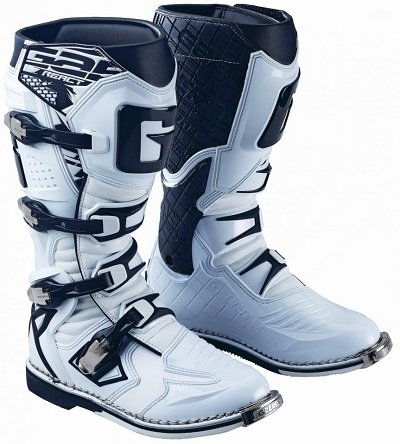
Cross Boots
Cross boots also deserve special attention. Legs in motocross are used like nowhere else. Pushing off, slowing down, falling, hitting obstacles, and riding in dirt – all this must be endured by boots. As a result, their manufacturing is similar to that of roller skates than normal boots. They do not usually need a slider, yet the base is reinforced, and in addition there is a special front cover made of steel that protects the base of the boot from rocks or other strong objects.
Motorcycle Gloves
Good gloves offer not only protection, but comfort as well during the ride. The wrong type of glove will get in the way while riding and its protector will not provide the protection it was designed for. Speaking about the types of gloves, we can divide them into four categories: Urban or city gloves, Sports, Touring, and Enduro gloves.
Also read: Choosing the right motorcycle glove
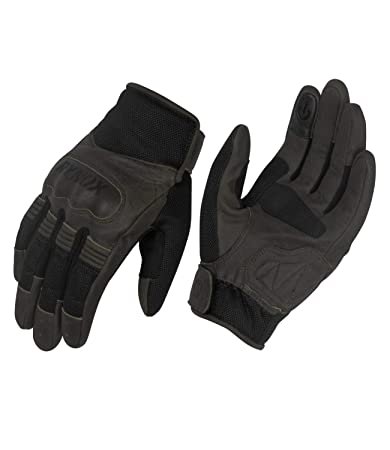
Urban Gloves
If you mainly ride a street bike, urban gloves are probably the right choice for you. Some of them are a little more athletic, while others are classic, but on the whole the essence is the same: they have cuffs shortened for convenience and do provide some kind of impact protection. Touch support is another feature common to many models in this category, as many riders use capacitive touchscreen devices on the go for navigation and multimedia. These gloves are made from textile or leather or sometimes both.
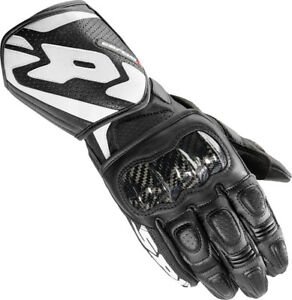
Sports / Racing Gloves
This category of motorcycle gloves is for aggressive track driving only. They are made of leather and have a high length cuff. Built on Gator Grip Technology, they cover the arms almost to the elbows. This technology prevents the glove from slipping during collision and has additional protective guards. Gloves of this type have knuckle protection, reinforced wrist guard and other supporting features. They are usually more expensive than other options due to their professional use.
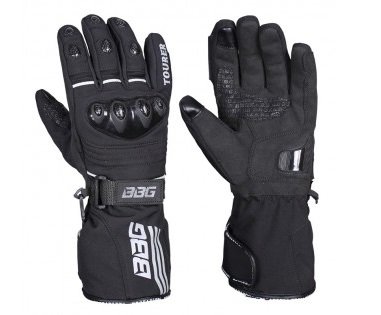
Touring Gloves
The versatility of touring gloves can hardly be overestimated. They usually have a full gator, but they are also smaller than sports versions. Usually these are textile or textile-leather gloves. Depending on the budget and preferences, these can be both simple (budget friendly) and sophisticated models (high priced) which are equipped with latest technologies. Nevertheless, they are worth every penny spent once you embark on an adventure.
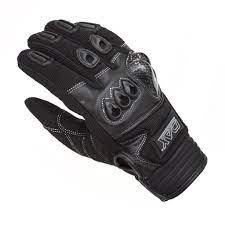
Enduro Gloves
Riders who prefer to trail on rough terrains have their own preferences in terms of gloves. These short gloves are usually made of textile or a combination of textile and leather. Their main feature is that they are minimally restrictive, because riding on rough terrains require frequent changes in position and riding stance, and long or stiff gloves will interfere with motorcycle control. At the same time, these gloves are necessarily equipped with protective elements, because falls are not uncommon even while riding off-road.
Things To Know Before Buying Your First Motorcycle Gear
If you are buying your first motorcycle gear there is a slight possibility that emotions can cloud your judgement. This often results in purchase of improper motorcycle gear that is not only uncomfortable but unsafe as well.
How to choose a motorcycle jacket?
In the event of an accident, the friction caused by sliding on the asphalt can rupture muscles. Thus it is important that motorcycle jackets must be made of a durable material that protects your skin. A common mistake is buying a regular jacket that only mimics a motorcycle jacket. A biker-style leather jacket or bomber jacket does not provide basic protection.
No matter how impressive a motorcycle rider looks in a leather jacket, this is the most stupid piece of gear. In the heat, the skin is unbearably hot, in the rain it is soaked in water and drying takes a very long time, and in the cold it does not really warm you up. The only advantage of leather is that it protects well when sliding at high speed on asphalt. That is why all professional riders around the track are covered in leather overalls. So even if you do slide on a track, you get up as if nothing has happened, dust off and go in search of your motorcycle. However, in the event of an accident in a city or on a public road, there is simply nowhere to slide. Cars, curbs, bumpers, dividers, poles, road signs, etc. will stop you quickly. And no jacket will save you from a strong blow against a hard obstacle.
So leave the leather to the professional riders and buy yourself a good textile jacket! Best of all is an elongated touring model. It will not bulge and expose your lower back when you get on the motorcycle. This is the most versatile, all-weather solution. A good touring jacket can quite comfortably adjust in the temperature range from 2° to 40° Celsius.

How is this versatility achieved? It is simple yet difficult. After all, a good motorcycle jacket is a modern engineering marvel – a kind of multilayer cake. The top layer protects you from wind and possible accidental damage. To do this, it is made of dense synthetic fabric such as Corduroy or Oxford. By and large, both are very dense nylon, additionally quilted on the most vulnerable places and reinforced with protective inserts made of genuine leather, artificial suede, rubber, plastic or carbon fiber. The most expensive models may even have aluminum or titanium linings. But these are not beginner jackets. So just make sure that the shoulders and elbows of your jacket are reinforced with something. This is the minimum required.
The second layer in the jacket is a windproof and waterproof insert. Best of all, it is made of a membrane fabric that allows air and moisture to go out, but not in. These inserts are often removable and if necessary, can be worn separately. And the third layer, also removable, is a warm lining. Most commonly, a thin quilted synthetic winterized lining responsible to keep you comfortable in cold weather. All these layers can be removed, put on or combined in such a way that you feel comfortable in any weather.
A characteristic feature of a good motorcycle jacket, especially textile jacket, is extra reinforcement on important areas such as the spine, elbows, shoulders and chest. They increase impact resistance and protect joints. Protective guards are made of foam, hard plastic or Kevlar. However, they should not be confused with the “armor” used when riding off-road.
Due to the fact that motorcycle jackets must provide at least basic protection from wind and rain, the breathability of the material itself is restricted. Thus, to avoid sweating, choose a motorcycle jacket with a closable ventilation system. It is generally located on the chest, sleeves and back. Thanks to it, the air will dry the body and the inner layers of clothing. Jackets with removable linings are a good option for touring during spring and fall.
Advice: It is important to note that the motorcycle jacket must be properly snugged to the body. In order to adapt to different body types, they usually come equipped with pullers. Only these types of jackets guarantee that the protective guards will not move relative to the body during an accident.
Do you need extra protection in a jacket?
It is true that even a deep-sea diving suit will not save you from a frontal impact against a Ford Pickup, but in less serious accidents you can be protected by special impact-absorbing inserts. In a good jacket there are five of them: on the shoulders, on the elbows and on the back. The first four are usually included. Make sure they are there, then after putting on your jacket, check that they are in place. The most common problem is with the elbows. The inserts in the sleeve should be strictly opposite the joint, and not dangle somewhere in the middle of the forearm. Protective inserts are often height-adjustable, but within a fairly narrow range. Therefore, if the sleeves are initially too big for you, then the adjustment may not be enough. This means that you will have to look for another variant of the jacket.
Usually inserts are made of a relatively soft material, somewhat reminiscent of elastic plastic or rubber. Such protection is inexpensive, but capable of effectively absorbing the energy of an impact in a collision. A more expensive option is inserts made of D3O material. When compressed, bent or stretched, it remains soft, and with sharp impacts it instantly hardens over its entire surface, redistributing and thus absorbing energy. And even if the tag of the jacket does not say that it is equipped with D3O inserts (which, of course, is unlikely), they are easy to recognize by their characteristic orange color. The basic guard is most often black or gray!
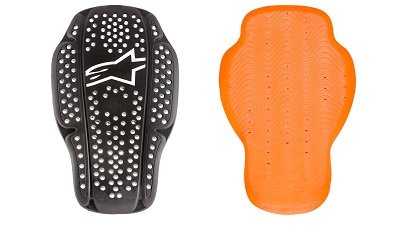
The back protector can be made from the same material as the protective inserts on the shoulders or elbows. More expensive models use D3O. And, the highest class (including the level of protection) are composite inserts, which are a sandwich of various materials. Which one to choose is completely up to you!
How much does a decent motorcycle jacket cost?
Since we’re talking about price, the more realistic question to ask here would be, how much does a good jacket cost? Unfortunately, the answer may not sound very pleasant. A really good touring jacket can cost $500, or $800 or even $1000. This is why some motorcyclists insure not only their motorcycles, but also their equipment! It is difficult to do this, but, it is possible.
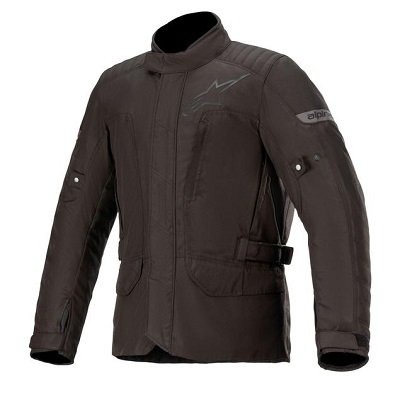
But if you need a more budgetary option, then more or less a decent jacket that satisfies the requirements described above can be bought for $200.
Which motorcycle pants you should buy as a beginner?
A motorcycle rider wearing a high quality motorcycle jacket and regular jeans is quite common. Many riders have a notion that a typical sporty motorcycle pant does not look appropriate for daily use. Additionally, jackets can be removed easily, but changing a pair of trousers is somewhat tedious. However, an injury to the lower body or pelvis can be equally dangerous and painful. The answer to this problem is motorcycle pants that look like regular jeans. However, they should have tear-resistant material, reinforced seams, and a good hip & knee protector. It is also important to note that the position of the protective guards should not be checked in a standing position, but in a slightly bent position, as when riding a motorcycle or while sliding.
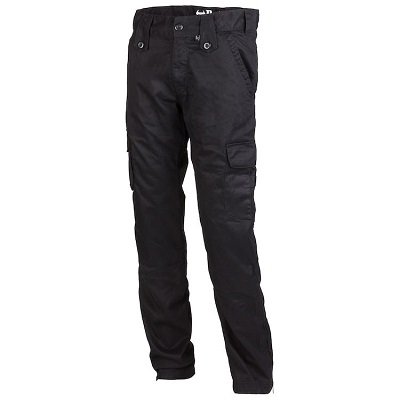
Can’t afford pants like this? Then put your knee pads on top of your trousers. Truth be told, wearing knee pads over trousers in a motorcycle environment is considered unfashionable and ugly. But in the end, the safety of your own knee joints is more important than someone else’s opinion of what is fashionable and what is not.
Best Knee Pads for Beginners
Let’s leave the complex knee braces and guards for professionals. Conventional motorcycle knee pads come with or without hinges. From a security standpoint, the former is better. With a strong blow, they prevent the knee from bending in the opposite direction. But you have to pay for everything – and not only in money. Hinged knee pads are not only more expensive, but also more massive. It is difficult to find trousers wide enough to stretch over the top. And while walking down the street, the hinges are likely to squeak and click, which will quickly infuriate even the calmest person.
A more affordable option is simple knee pads, parts of which are attached to each other with some kind of soft textile material. They are easier to carry and much easier to buy. And literally any will do – even those that are sold in sports stores with ski equipment. There is no fundamental difference between motorcycle and non-motorcycle models. Such a purchase will cost you only $20-$30.
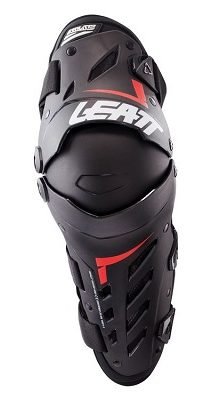
However, for a decent model, you will have to pay $50-$80. And with a budget like this, it would be wise to opt for renowned brands like Alpinestars, Leatt, EVS, Acerbis and Thor. Besides, some knee pads are also made of high-tech D3O material. Such models are in line-up with Icon; an American motorcycle gears and equipment company.
Which beginner motorcycle helmet to choose?
The most important piece of gear for a biker is the helmet. Above all, avoid the cheap ones. Don’t think that a $50 priced helmet will be of high quality equipped with all the safety features.
A good quality motorcycle helmet undergoes a series of endurance tests. They come approved under DOT, ECE, SHARP or SNELL. It should also be kept in mind that a full faced or integral helmet is the most ideal one among all the types that protects the head and face. Equally important is the comfort of riding in a helmet. The helmet must be adjusted so that it does not rotate freely on the head, but does not press on either. You should also take into account the fact that over time the soft lining of the helmet will snuggle and become a little loose. Effective head ventilation is an important factor affecting comfort. And in order to avoid foggy visor choose a helmet with a hydrophobic coating or pinlock (prevents the formation of steam). Yet again, on sunny days, sun blinds will be invaluable.
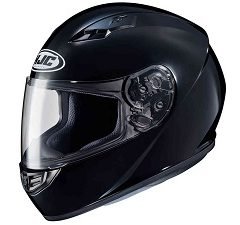
A full faced budget model made of polycarbonate, something like the Korean HJC CS-15 or the Chinese LS2 model FF320 can be the most ideal beginner helmet. The former is slightly cheaper, but the latter is equipped with an internal sun visor. Both, however, are heavy – about 1.6 kilograms (and may weigh even a little more, depending on the size), but are an excellent choice.
How to choose motorcycle boots?
Similar to jackets and trousers, motorcycle boots must be made of durable or non-breakable material. Not only they should have ankle and toe protectors to protect the foot from injury, but they should properly fit in order to strengthen the ankle and prevent any joint dislocation during an accident.
Motorcycle boots must also meet a number of other conditions. They should have a smooth and reinforced upper so that you can comfortably shift the gears. They should have a fastener or buckle to tie them tightly and at the same time they should provide a good “feel”. This is necessary to facilitate precise braking and downshifting.
If we talk about budget shoes, then you can go to any store that sells army equipment and buy the simplest domestic ankle boots. Necessarily leather! And higher their length towards the knees, the better they are safety wise. It should be noted that in terms of the level of protection they should not be compared with specialized motorcycle boots, especially with racing models. But they will cost only $50 and will be better than “urban” sneakers. In addition, the ankle boots are practically all-weather, and if they are additionally coated with a special solution (you can find it in any shoe store), they will not get wet for a long time even in heavy rain.
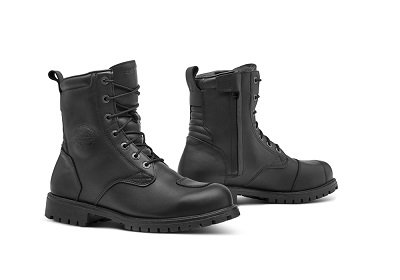
Just don’t be lazy to lace them up tightly every time. The ankle must be firmly fixed! Laces can be long and dreary, so there are special motorcycle ankle boots on the market, equipped, in addition to laces, with a side zipper. For example – the Legacy model from the Italian company Forma. Putting them on is much faster and more convenient, but you will have to pay at least $150 for comfort.
Bottom Line
You are dressed, shod, pretty decently protected and your appearance does not dissonant with the prevailing image of a motorcyclist. All this cost you about $600. And this, believe us, is inexpensive – we have saved on everything that is possible.
But don’t think it is over. This is where your spending begins. If you really start riding every day, regardless of the weather, then in the very near future you will still need a spare pair of gloves and a raincoat – a waterproof jumpsuit that is worn over all other equipment. Because if you remain for a long time in heavy rain, then even the best waterproof jacket won’t save you. And, contrary to all our advice and arguments, you will certainly think about buying a beautiful leather jacket (and who doesn’t want it). Then again, you will come across fashionable motorcycle jeans in some motorcycle store… In other words, everything is just beginning. Because you have become a motorcyclist and your life is finally filled with new meaning!


